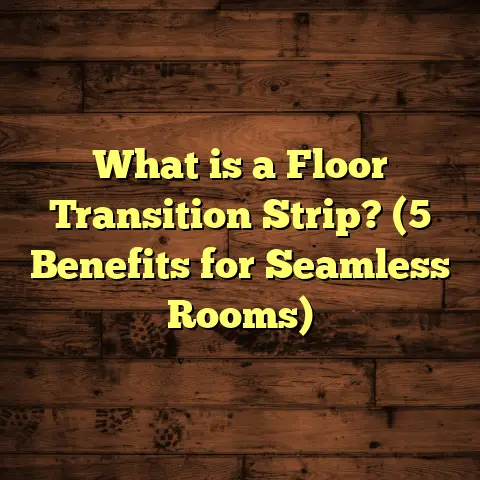What is Hardwood Floor Cupping? (5 Causes & Solutions Revealed)
Craftsmanship has always fascinated me. The way a skilled craftsman transforms raw wood into a beautiful hardwood floor is like watching magic happen. It’s not just about nailing down planks; it’s about understanding the wood’s character, how it reacts to its environment, and how every small detail can affect the final look and longevity of the floor. Over the years, I’ve seen many hardwood floors perform beautifully, but I’ve also encountered problems that can be frustrating for any homeowner or installer—one of the most common being hardwood floor cupping.
What is Hardwood Floor Cupping?
You might have noticed that sometimes a hardwood floor doesn’t lay flat. Instead, the edges of the boards seem raised while the center looks sunken. That phenomenon is known as cupping. In more technical terms, it’s when a hardwood plank curves so that its edges are higher than its middle, creating a shallow bowl-like effect.
This isn’t just an aesthetic issue—cupping can make floors feel uneven underfoot and even cause squeaks or gaps between boards over time. But why does this happen? It all comes down to wood’s natural reaction to moisture.
Wood is hygroscopic, which means it absorbs and releases moisture depending on its surroundings. When the moisture level underneath the plank is higher than on top, the bottom side swells more than the top, causing the edges to rise.
Understanding this process is key to preventing and fixing cupping before it becomes a serious problem.
Why Does Cupping Matter So Much?
I want to stress why cupping is something to take seriously. It doesn’t just affect how your floor looks—it can lead to long-term damage if ignored. From my experience, minor cupping might seem harmless at first, but it can worsen with continued moisture exposure. This can cause boards to weaken at seams or even detach.
Plus, cupping often signals underlying moisture problems that could affect other parts of your home, like subfloor damage or mold growth. Ignoring it is like ignoring a warning light on your car—it may cost you much more in repairs later.
The 5 Main Causes of Hardwood Floor Cupping
Let me break down the top causes of cupping I’ve seen consistently throughout my career:
1. Excess Moisture Below the Floor
One of the most frequent reasons for cupping is moisture trapped beneath the flooring. Whether you have a crawl space, basement, or concrete slab underneath, moisture can creep up from below if there’s inadequate vapor protection or poor ventilation.
I once worked on a home where the homeowners kept noticing cupped boards in only one room. After some digging, we found that a nearby bathroom had a leaking pipe causing water to saturate the subfloor. The moisture didn’t just stay in one place—it spread under the hardwood and caused swelling.
Data insight: According to the National Wood Flooring Association (NWFA), subfloor moisture greater than 14% significantly increases the risk of cupping. Floors installed without adequate vapor barriers experience up to 40% more issues with moisture-related defects.
2. High Indoor Humidity
Humidity inside your home also plays a massive role in wood behavior. Wood expands when humidity rises because it absorbs moisture from the air. When indoor air has high relative humidity (above 60%), hardwood planks absorb water unevenly—especially if air circulation beneath the floor differs from above it.
In coastal areas or regions with hot summers, I often recommend using dehumidifiers to maintain indoor humidity between 30-50%. This range helps keep wood stable without drying it out excessively.
A client who lived near the Gulf Coast told me their floors started cupping after a particularly humid summer. Installing a whole-house dehumidifier combined with sealing crawl spaces resolved the problem within months.
3. Skipping or Rushing Acclimation
Acclimation means letting hardwood sit in the environment where it will be installed before laying it down. This allows the wood to adjust to temperature and humidity conditions so it stabilizes in size and shape.
I cannot stress enough how many times improper acclimation caused problems later on. One contractor I know rushed through installation by skipping acclimation entirely, resulting in widespread cupping that showed up within weeks.
The rule of thumb is at least 72 hours of acclimation in the installation room under normal living conditions. For engineered hardwood or very thick planks, sometimes longer is needed.
4. Water Spills and Flooding
Accidents happen—whether due to plumbing failures or everyday spills—but standing water or excess moisture on hardwood floors causes rapid cupping.
I once helped a family recover their floors after a bathroom flood went unnoticed overnight. The water seeped deep into the boards, causing severe cupping and warping. Fast professional drying saved some of the floorboards, but many had to be replaced.
Timely cleanup is critical to avoid permanent damage.
5. Subfloor Problems
The condition of your subfloor matters just as much as your top hardwood layer. An uneven or moist subfloor puts stress on boards above.
In older homes with plywood or concrete subfloors that lack proper vapor barriers, I’ve seen persistent moisture pockets cause repeated cupping issues even after new flooring installation.
Sometimes resolving this requires repairing or replacing subfloor sections and installing moisture barriers.
How to Fix Hardwood Floor Cupping: Tried and Tested Solutions
Finding out what caused your floor to cup is the first step—fixing it is next. Here’s what I recommend:
Moisture Management Is Non-Negotiable
The best way to fix cupping is to eliminate excess moisture sources. This means:
- Installing vapor barriers under subfloors
- Sealing crawl spaces and basements adequately
- Improving ventilation
- Using dehumidifiers indoors during humid months
By controlling moisture levels on both sides of the wood plank, you reduce swelling risks dramatically.
Proper Acclimation Before Installation
Always let your wood acclimate fully before installation. For me, this has become a strict rule on every project.
If you’re redoing floors after cupping issues, removing damaged planks and reinstalling after proper acclimation can prevent recurrence.
Dry Out Wet Floors Quickly
If you ever experience flooding or spills, act fast:
- Remove standing water immediately
- Use fans and dehumidifiers to dry floors and subfloors
- Avoid using heat directly on wood as this can cause cracks
Prompt drying stops moisture from penetrating deeply into wood fibers.
Sand and Refinish Mild Cases
If cupping isn’t severe and moisture has been controlled, sanding can often smooth uneven surfaces back down.
I’ve done this countless times with success—usually combined with refinishing coats of polyurethane or oil-based finishes for protection.
Replace Severely Damaged Boards
When boards are warped beyond repair, replacement is necessary. Match new planks for species and moisture content for the best results.
Make sure underlying moisture issues are fixed before installing replacements to avoid repeating problems.
My Personal Experiences with Hardwood Floor Cupping
Let me tell you about a few cases I’ve worked on that highlight how tricky and rewarding these fixes can be.
Case Study 1: The Coastal Home Challenge
A family in Florida called me after noticing their beautiful Brazilian cherry floors were cupping badly after just one year. They had installed them over a concrete slab without a vapor barrier due to cost concerns.
I tested moisture levels in their slab—it was consistently above 16%. We installed a vapor barrier over the slab then reinstalled new flooring after thorough acclimation in their home conditions.
Six months later? No cupping at all. They were thrilled they didn’t need full replacement again.
Case Study 2: Rushed Installation Gone Wrong
Another client had their maple floors installed by a contractor who skipped acclimation completely due to schedule pressure. The floors cupped badly within weeks.
We carefully removed affected planks, let all materials acclimate for five days under controlled humidity (45%), then reinstalled everything properly.
The floors stayed perfect for years afterward—proving how vital acclimation really is.
Technical Insights: Understanding Wood Behavior with Moisture
Wood’s response to moisture changes can be surprisingly complex:
- Wood fibers expand across the grain more than along the grain.
- The bottom of a plank exposed to moisture swells more than the drier top side.
- This imbalance is what causes board edges to lift (cupping).
- Relative humidity between 30-50% keeps wood dimensionally stable for most species.
- Exceeding 60% RH regularly increases risk for expansion problems including cupping, crowning, and buckling.
Species also matter:
- Oak tends to be fairly stable but still susceptible.
- Maple can expand more due to tighter grain.
- Brazilian cherry expands significantly but offers beautiful color.
- Engineered hardwood reduces risk by using plywood layers beneath real wood veneer for dimensional stability.
Maintenance Tips to Keep Your Hardwood Floor Flat and Beautiful
Once you have your floors properly installed and free from cupping, keeping them that way requires ongoing care:
- Use area rugs in high-moisture zones like kitchens.
- Control indoor humidity year-round using humidifiers/dehumidifiers.
- Clean spills quickly—never let liquids pool.
- Avoid wet mopping; use damp cloths instead.
- Inspect crawl spaces and basements annually for leaks or excess moisture.
- Schedule professional inspections every few years for peace of mind.
Comparing Hardwood Floor Cupping with Other Flooring Issues
You might have heard of other hardwood floor problems and wondered how they differ from cupping:
| Issue | Description | Cause | Severity | Fix Difficulty |
|---|---|---|---|---|
| Cupping | Edges higher than center (concave) | Moisture imbalance (bottom wetter) | Moderate | Moderate |
| Crowning | Center higher than edges (convex) | Moisture imbalance (top wetter) | Moderate | Moderate |
| Buckling | Boards lift off subfloor | Extreme moisture / structural issues | Severe | Difficult |
| Gapping | Visible gaps between boards | Low humidity causing shrinkage | Minor to moderate | Easy |
Compared to synthetic options:
- Laminate flooring resists moisture better but lacks refinishing ability.
- Vinyl flooring won’t cup but lacks real wood aesthetics.
- Engineered hardwood balances natural look with better stability than solid wood but can still cup if exposed to water long-term.
How Tools Like FloorTally Help Me Manage Projects Better
Estimating costs for hardwood projects can be tricky—especially when factoring in repairs like fixing cupping problems which may involve subfloor work or new materials.
I use tools like FloorTally because they let me input precise data: room dimensions, wood types, local labor costs, waste factors, and installation methods. It gives me detailed estimates quickly so I can plan financially ahead without surprises.
While it’s just one part of my workflow, having reliable cost data helps me communicate clearly with clients and avoid common budgeting headaches.
Final Thoughts: Taking Care of Your Hardwood Floors
Hardwood floors are an investment in your home’s beauty and value—and keeping them looking their best involves understanding how they react to environmental factors like moisture.
Cupping isn’t just a cosmetic issue; it signals something going wrong beneath your feet that you should address promptly. From controlling moisture below floors to proper acclimation before installation—and quick action on water spills—you can save yourself from costly repairs later on.
If you’re considering hardwood flooring or dealing with cupped floors currently, don’t hesitate to reach out for expert advice tailored to your situation. With patience and care, you’ll enjoy gorgeous flat floors for decades.
And hey—if you want help comparing options between solid hardwood, engineered wood, laminate, or vinyl based on your budget and lifestyle, just ask me anytime!
If you have questions or want me to dive deeper into any part—whether detailed installation tips or troubleshooting specific species—let me know! I’m here to help you get your floors right without guesswork or regrets.
Would you like me to create detailed guides on preventing other flooring issues like buckling or gapping next? Or maybe a breakdown on choosing between flooring types based on climate? Just say the word!





